In the vast prehistoric landscape of Late Cretaceous North America, few dinosaurs have captured the public imagination quite like Triceratops horridus. With its distinctive three-horned face, massive shielded frill, and robust body, this herbivorous giant has become one of the most recognizable dinosaurs in scientific and popular culture alike. Discovered in the late 19th century, Triceratops has provided paleontologists with remarkable insights into dinosaur biology, behavior, and evolution. This charismatic ceratopsian roamed the western regions of North America approximately 68 to 66 million years ago, making it one of the last non-avian dinosaurs to exist before the catastrophic mass extinction event that marked the end of the Mesozoic Era. Its fossils tell a fascinating story of adaptation and survival in an ancient world dominated by formidable predators like Tyrannosaurus rex.
Discovery and Naming Origins
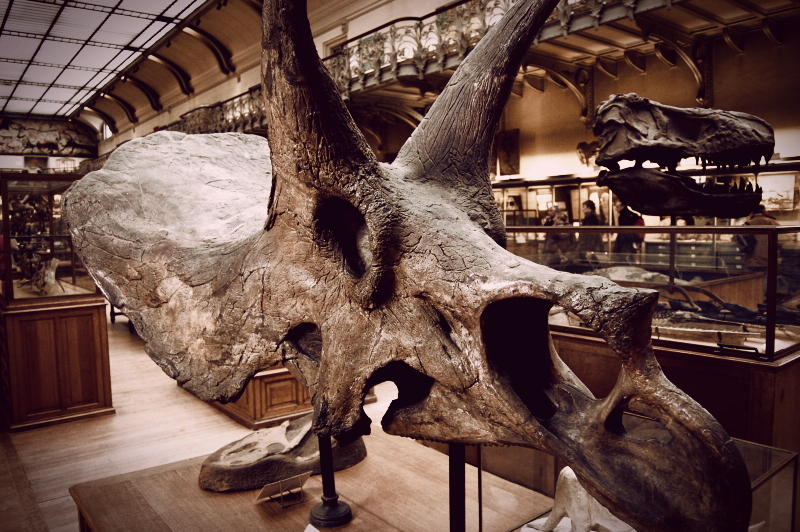
The first Triceratops fossils were discovered in 1887 near Denver, Colorado, when a pair of distinctive horns caught the attention of paleontologist Othniel Charles Marsh. Initially, Marsh mistakenly identified the specimen as belonging to an extinct species of bison, but further fossil discoveries soon revealed the true nature of this prehistoric creature. In 1889, Marsh formally named the genus Triceratops, derived from Greek words meaning “three-horned face,” a perfectly descriptive name for this distinctive dinosaur. The specific epithet “horridus” translates to “rough” or “rugged,” referring to the textured appearance of its skull. This naming represents one of the most appropriate and descriptive taxonomic designations in paleontology, instantly conveying the animal’s most striking features.
Fossil Distribution and Habitat

Triceratops fossils have been found primarily in western North America, with the richest deposits located in the Hell Creek Formation, which spans parts of Montana, Wyoming, North and South Dakota, and extends into Canada’s Saskatchewan province. These fossil-bearing sediments represent ancient floodplains, river deltas, and coastal lowlands that existed during the Late Cretaceous period. Paleoenvironmental evidence suggests Triceratops inhabited warm, subtropical regions with seasonal rainfall patterns, populated by diverse plant communities including conifers, ferns, cycads, and early flowering plants. The widespread distribution of Triceratops fossils indicates these animals were highly successful and abundant across their range, likely traveling in groups through the mixed forests and open woodlands that characterized their ecosystem.
Physical Characteristics and Size
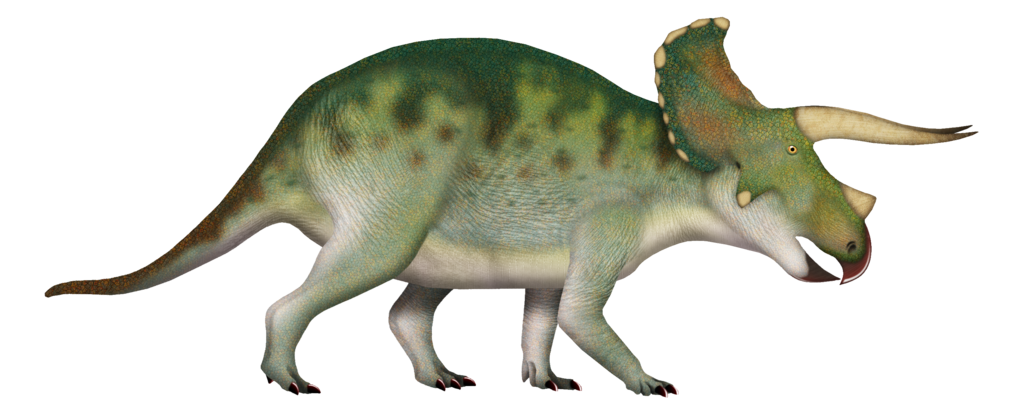
Triceratops stands as one of the largest ceratopsians ever to have existed, with adults reaching lengths of 25 to 30 feet (7.6 to 9 meters) and weighing an estimated 6 to 12 tons. Its massive skull, which could grow to over 8 feet (2.4 meters) in length, represents one of the largest heads of any land animal in Earth’s history. The distinctive facial features included a short horn above the nose and two longer, forward-facing horns above the eyes that could extend up to 3 feet (1 meter) in length. The rear portion of the skull expanded into a remarkable solid bone frill that extended back over the neck, reaching widths of up to 6 feet (1.8 meters) in the largest specimens. Triceratops moved on four sturdy, column-like limbs, with the front legs shorter than the hind legs, giving the animal a somewhat hunched appearance with its head carried relatively low to the ground.
The Function of Horns and Frill
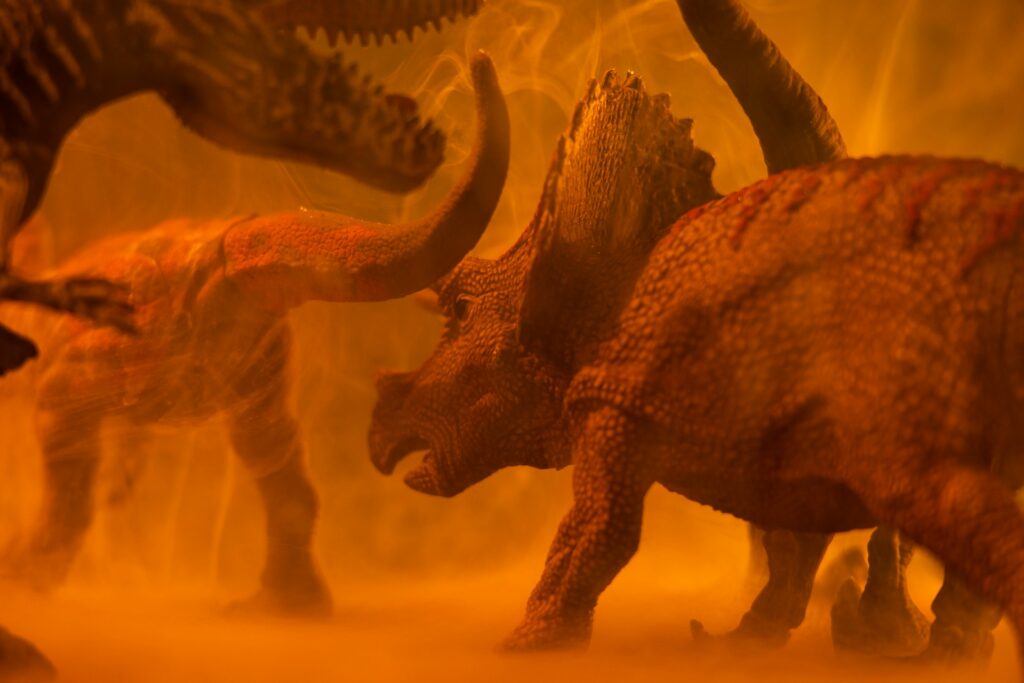
The purpose of Triceratops’ iconic horns and frill has been the subject of considerable scientific debate and research. While defense against predators like Tyrannosaurus rex represents the most intuitive explanation, paleontologists now recognize these structures likely served multiple functions. The horns and frill almost certainly played crucial roles in species recognition and sexual display, with variations potentially helping individuals identify suitable mates within their own species. Fossil evidence of horn injuries and healed wounds suggests these weapons were actively used in combat between Triceratops individuals, likely during competition for mates or territory. The solid bone frill, unlike the fenestrated (hole-filled) frills of related ceratopsians, provided substantial protection for the vulnerable neck region while simultaneously offering a large canvas for visual signaling through color or patterns that would have been visible on the keratinous covering that once sheathed the bone.
Diet and Feeding Mechanisms

Triceratops was an obligate herbivore with a remarkable feeding apparatus specialized for processing tough plant material. Its distinctive parrot-like beak at the front of the jaws could snip vegetation with precision, while batteries of tightly packed teeth arranged in dental batteries formed effective grinding surfaces for breaking down fibrous plant matter. Each jaw contained hundreds of teeth arranged in columns of 36 to 40 teeth each, with new teeth continuously growing and replacing older, worn teeth throughout the animal’s life. This efficient system allowed Triceratops to process large amounts of coarse vegetation, likely including cycads, ferns, palms, and early flowering plants. The powerful jaw muscles, anchored to the expansive frill, generated tremendous bite forces that could crush even the toughest plant fibers, giving Triceratops access to food sources unavailable to many other herbivores of its time.
Growth and Development
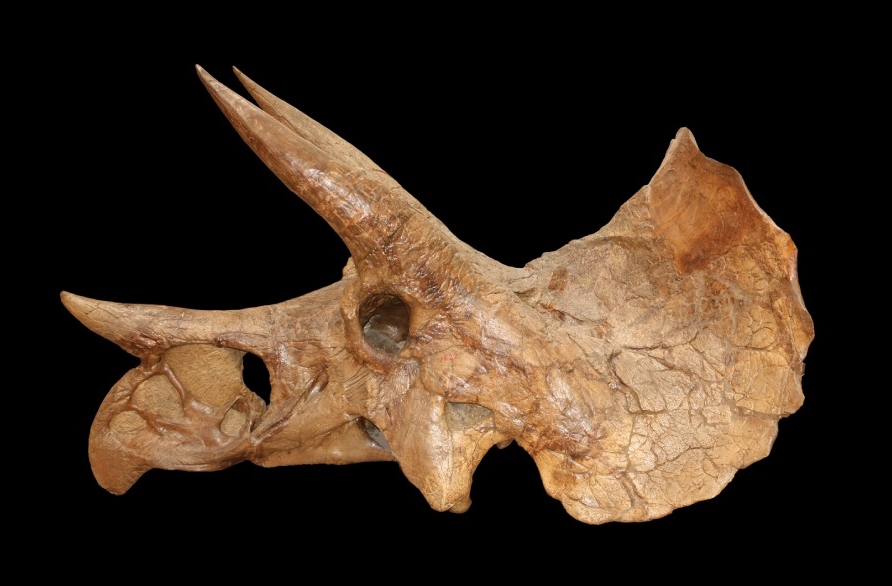
Recent studies of Triceratops growth patterns have provided fascinating insights into the life history of these remarkable dinosaurs. Examination of bone microstructure and growth rings indicates Triceratops experienced rapid growth during its early years, potentially reaching sexual maturity between 7 and 10 years of age. The full adult size was likely achieved after approximately 15 to 20 years, though growth continued at a slower rate throughout life. The distinctive cranial features, particularly the horns and frill, underwent dramatic changes during development, with juvenile Triceratops displaying shorter, straighter horns that curved forward and elongated as the animal matured. These ontogenetic changes were so pronounced that some specimens initially classified as separate species (such as “Torosaurus”) are now considered by many researchers to represent mature or elderly Triceratops individuals, though this remains debated in paleontological circles.
Social Behavior and Herd Dynamics
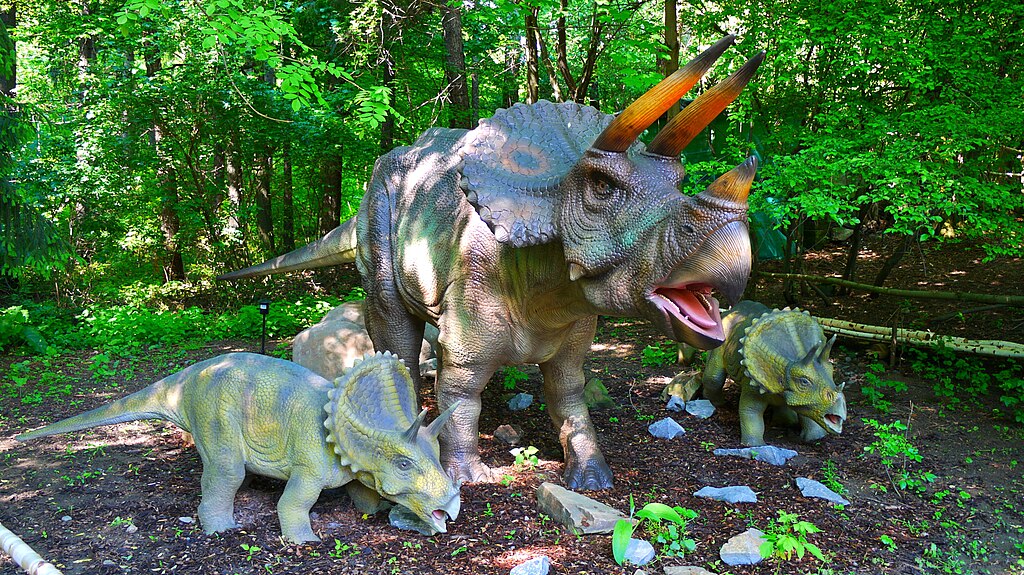
While direct evidence of Triceratops social behavior remains limited, several lines of evidence suggest these dinosaurs likely exhibited some degree of social organization. Multiple Triceratops individuals have been found in close proximity at certain fossil sites, suggesting these animals at least occasionally gathered in groups. The presence of specialized display structures (horns and frills) also points toward complex social interactions requiring visual communication between individuals. Modern ecological analogs, such as rhinoceroses, suggest Triceratops may have formed small family groups or loose aggregations for protection, particularly when young were present. Juvenile Triceratops specimens indicate parental care was likely substantial, with young animals potentially remaining with adults for extended periods while they developed the size and defensive capabilities needed to deter predators independently.
Predator-Prey Relationships

The primary predator of adult Triceratops was undoubtedly Tyrannosaurus rex, the apex predator that shared its Late Cretaceous habitat. This dramatic predator-prey relationship has been immortalized in museum displays and popular media for generations. Compelling evidence for these interactions comes from Tyrannosaurus teeth found embedded in Triceratops bones, along with healed injuries on Triceratops fossils indicating individuals survived attempted predation. The defensive capabilities of Triceratops were formidable, with the forward-facing horns capable of inflicting serious damage to attacking predators. Fossil evidence suggests confrontations between these species were genuine ecological interactions rather than merely hypothetical scenarios. Young or weakened Triceratops would have been particularly vulnerable, while healthy adults with their imposing size and weaponry would have presented a dangerous challenge even for the mighty Tyrannosaurus.
Species Diversity Within the Genus
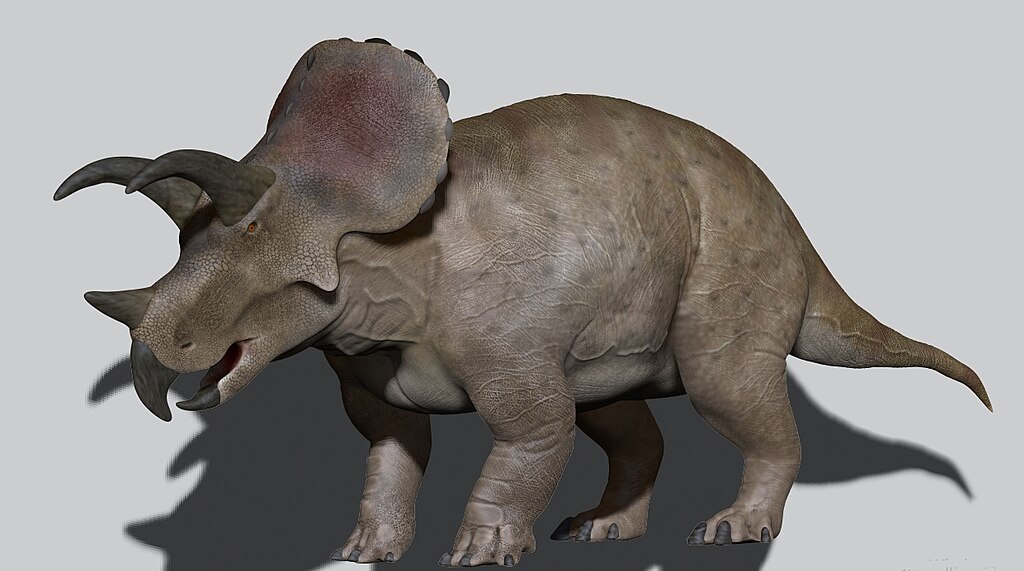
While Triceratops horridus remains the type species and most recognized member of the genus, paleontologists have identified potentially two valid species within Triceratops. The second recognized species, Triceratops prorsus, is distinguished primarily by its longer, more forward-projecting nasal horn and slightly different frill proportions compared to T. horridus. Other proposed species have been described historically, including T. elatus, T. calicornis, and T. obtusus, but most of these are now considered synonymous with either T. horridus or T. prorsus, representing normal variation within populations or different growth stages. The taxonomy remains somewhat fluid, with ongoing research and new fossil discoveries continuously refining our understanding of variation within the genus. The remarkable diversity in horn and frill configurations observed in Triceratops specimens likely represents a combination of individual variation, sexual dimorphism, and changes during growth rather than truly distinct species.
Evolutionary Relationships

Triceratops belongs to the family Ceratopsidae within the larger group Ceratopsia, a diverse lineage of ornithischian dinosaurs characterized by their beaked faces and various cranial ornamentations. Within Ceratopsidae, Triceratops is classified in the subfamily Chasmosaurinae, characterized by elongated frills and prominent brow horns. Its closest relatives include Torosaurus (though as mentioned, some consider this to be synonymous with mature Triceratops) and Nedoceratops. The ceratopsid dinosaurs underwent a remarkable evolutionary radiation during the Late Cretaceous, particularly in western North America, producing a diverse array of horned dinosaurs with varying frill and horn configurations. Triceratops represents one of the last and most specialized members of this lineage, appearing relatively late in the evolutionary history of ceratopsians and surviving until the very end of the Cretaceous period.
Cultural Impact and Scientific Significance

Few prehistoric animals have achieved the level of cultural recognition enjoyed by Triceratops, which has been featured prominently in scientific literature, popular books, films, television, toys, and museum exhibitions worldwide since its discovery. Its distinctive three-horned face has become an iconic representation of the dinosaur age, instantly recognizable even to young children. In scientific terms, Triceratops remains exceptionally important due to the abundance of well-preserved fossils, including numerous complete or nearly complete skulls that allow detailed study of its anatomy and development. The Hell Creek Formation, where many Triceratops fossils are found, preserves the final chapter of dinosaur evolution before the mass extinction, making these fossils crucial for understanding Late Cretaceous ecosystems. Triceratops also provides one of the best-documented examples of dinosaur-dinosaur interactions through its relationship with Tyrannosaurus.
Extinction Context

Triceratops lived during the final stages of the Cretaceous Period, vanishing in the mass extinction event that occurred approximately 66 million years ago. This catastrophic event, triggered primarily by a massive asteroid impact at Chicxulub, Mexico, eliminated approximately 75% of all species on Earth, including all non-avian dinosaurs. Fossil evidence indicates Triceratops populations remained robust and diverse right up until this extinction boundary, with specimens found in the uppermost layers of Cretaceous sediments. Unlike some dinosaur lineages that show signs of declining diversity before the extinction, Triceratops appears to have been thriving when their world abruptly ended. The sudden disappearance of these successful animals underscores the devastating and indiscriminate nature of the end-Cretaceous mass extinction, which fundamentally reshaped Earth’s ecosystems and cleared evolutionary space for the subsequent rise of mammals.
Recent Discoveries and Ongoing Research

Paleontological work on Triceratops continues to yield exciting new insights into this remarkable dinosaur. Recent discoveries include exceptionally preserved specimens with skin impressions that provide direct evidence of the scaly, non-feathered integument covering these animals. Advanced technological approaches, including CT scanning and 3D modeling, have allowed researchers to investigate aspects of Triceratops biology previously inaccessible, such as brain morphology, sensory capabilities, and blood vessel pathways within the distinctive frill. Histological studies examining microscopic bone structure have revolutionized our understanding of Triceratops growth patterns and life history. The controversial “Torosaurus question” – whether Torosaurus represents a separate genus or merely adult Triceratops – remains an active area of scientific investigation, with researchers presenting evidence on both sides of this taxonomic debate. Each new discovery adds to our understanding of these magnificent animals that dominated the North American landscape during dinosaurs’ final chapter.
Conclusion
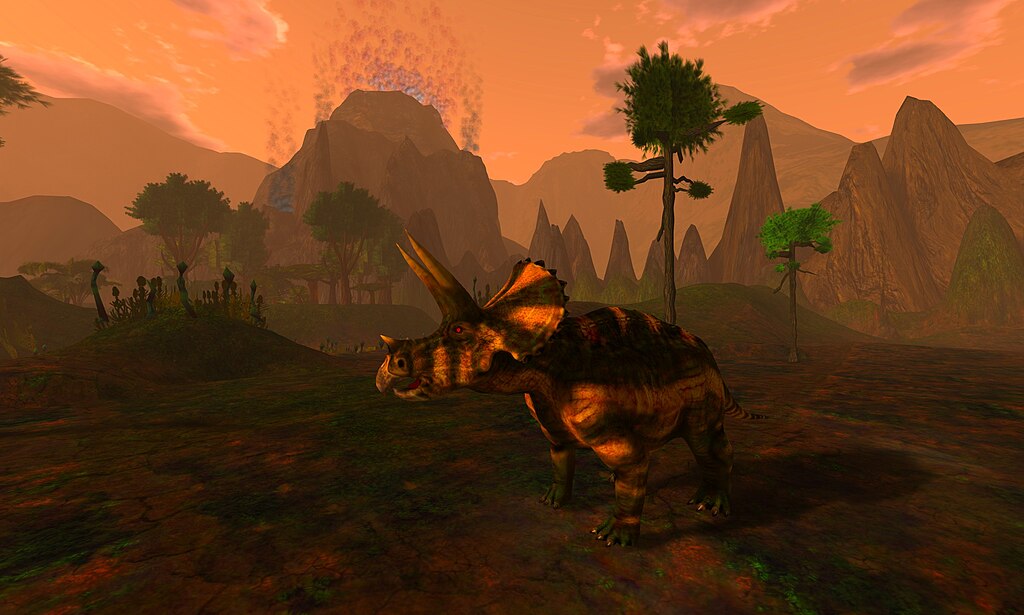
Triceratops horridus stands as one of paleontology’s most significant and beloved dinosaurs, a creature whose remarkable adaptations and imposing presence continue to captivate scientific and public imagination alike. From its massive three-horned skull to its powerful plant-processing jaws, every aspect of Triceratops anatomy reveals evolutionary solutions to the challenges of survival in the Late Cretaceous ecosystems of North America. As one of the last non-avian dinosaurs to walk the Earth before the asteroid impact that ended the Mesozoic Era, Triceratops provides a crucial window into the culmination of dinosaur evolution after 165 million years of dominance. Though separated from us by 66 million years, Triceratops remains vibrantly alive in our collective consciousness, a testament to both the remarkable discoveries of paleontology and the enduring power of these magnificent ancient creatures to inspire wonder across generations.



